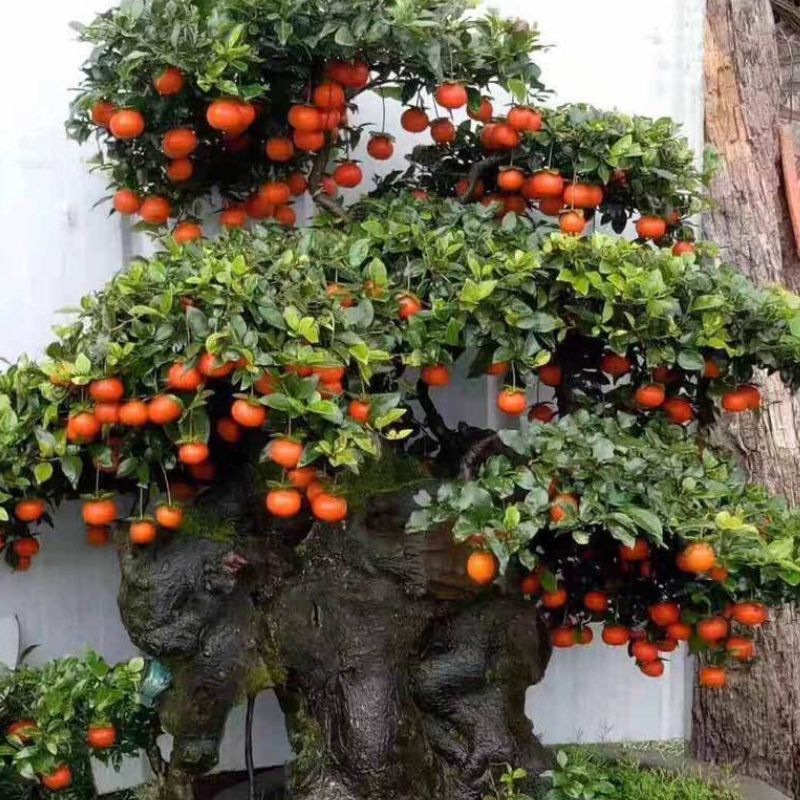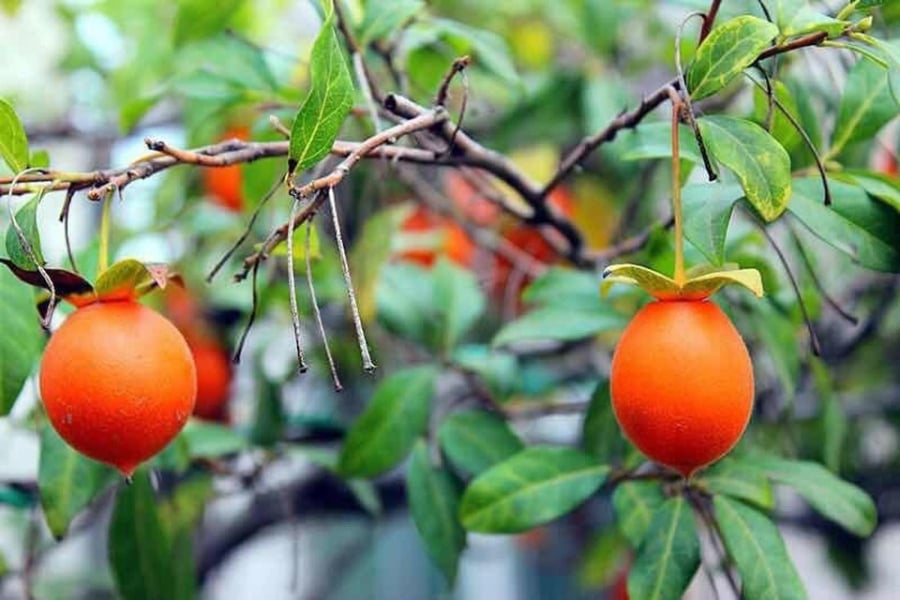The Marble Ebony tree, scientifically known as Diospyros cathayensis or Cathay persimmon, is an attractive woody plant with a straight, sturdy trunk and impressive spiraling twists. Its gray bark has a rough texture, contributing to its distinctive beauty.
The tree’s leaves are oval-shaped, a deep shade of green, and grow densely, offering a refreshing and vibrant feel to its surroundings. Though the flowers, which usually bloom in April and May, are not particularly showy, the tree’s presence adds a unique charm to any garden.
The Marble Ebony tree typically bears fruit in August. The unripe fruits are green, gradually turning a vibrant yellow-orange. This tree produces an abundance of long-stemmed fruits that dangle from its branches like precious gems, creating a stunning visual display. Notably, the fruits can remain on the tree for up to eight months, enhancing its decorative value.

Marble Ebony Tree Bearing Fruit in August
In the realm of feng shui, the Marble Ebony tree is believed to bring good fortune. Its dense canopy and strong roots symbolize unity and mutual support, representing harmony and solidarity in life.
The abundance of fruits on this tree signifies not only financial prosperity but also a lively and joyful atmosphere. Known for its vigorous vitality, this tree can live for up to hundreds of years, making it a symbol of longevity and resilience. The affluent often favor planting Marble Ebony trees in their living spaces, attracting wealth and wishing for a prosperous and abundant life.
Propagation of the Marble Ebony tree is commonly done through grafting. However, due to the presence of tannin in the tree, which can lead to oxidation and hardening, healers must pay close attention to the process. To increase the success rate of grafting, it is best performed when the tree produces less sap.
The ideal time for grafting Marble Ebony trees is from late August to early September, when weather conditions are favorable and the survival rate of the grafts is highest.

Ideal Timing for Grafting: Late August to Early September
When caring for a Marble Ebony tree, there are several important factors to consider:
Soil
A mixture of forest soil, garden soil, and a small amount of pearl stone can be used to create a well-aerated and porous environment for the tree. Alternatively, adding straw or sawdust to the soil is also beneficial.
Light
Marble Ebony trees thrive in bright, sunny conditions. However, newly transplanted trees can be sensitive to strong light, so it is essential to provide some shade as they adjust to their new environment. This will greatly aid their development, as unprotected exposure can lead to sun scorching and wilting.
Once the tree has settled and is growing well, you can gradually increase its exposure to direct sunlight. Throughout its life, ensure it receives ample light, but during the height of summer, provide some shade from the intense rays.

Marble Ebony Trees Thrive in Bright, Sunny Conditions
Watering
Marble Ebony trees prefer a moist environment for optimal growth, but they are susceptible to waterlogging. Therefore, water only when the surrounding soil is completely dry to avoid water accumulation and root rot. A helpful tip is to spray water around the planting area to enhance the appearance of the fruits, making them more visually appealing.
Fertilizer
To ensure vigorous growth, providing adequate nutrition is crucial. Like all plants, Marble Ebony trees require a reasonable amount of fertilizer to support their development.
During the initial flowering stage, apply fertilizers that promote blooming, such as phosphorous and potassium, to encourage more flowers and, consequently, a higher yield of fruits. This fertilization process should be repeated approximately every 20 days.
Throughout the tree’s growth, maintain a bi-monthly fertilization routine, using fertilizers high in nitrogen to promote robust growth and allow the tree to reach its full potential.
The Three Money-Magnet Creatures: Inviting Wealth into Your Home
Introducing the ancient art of physiognomy: an intriguing practice that delves into the connection between an individual’s features and their destiny. This age-old belief system holds that certain animals, when present in one’s home, bring about a sense of completion and heralds prosperity and success beyond measure. Uncover the secrets within and embrace a life of abundance.






































